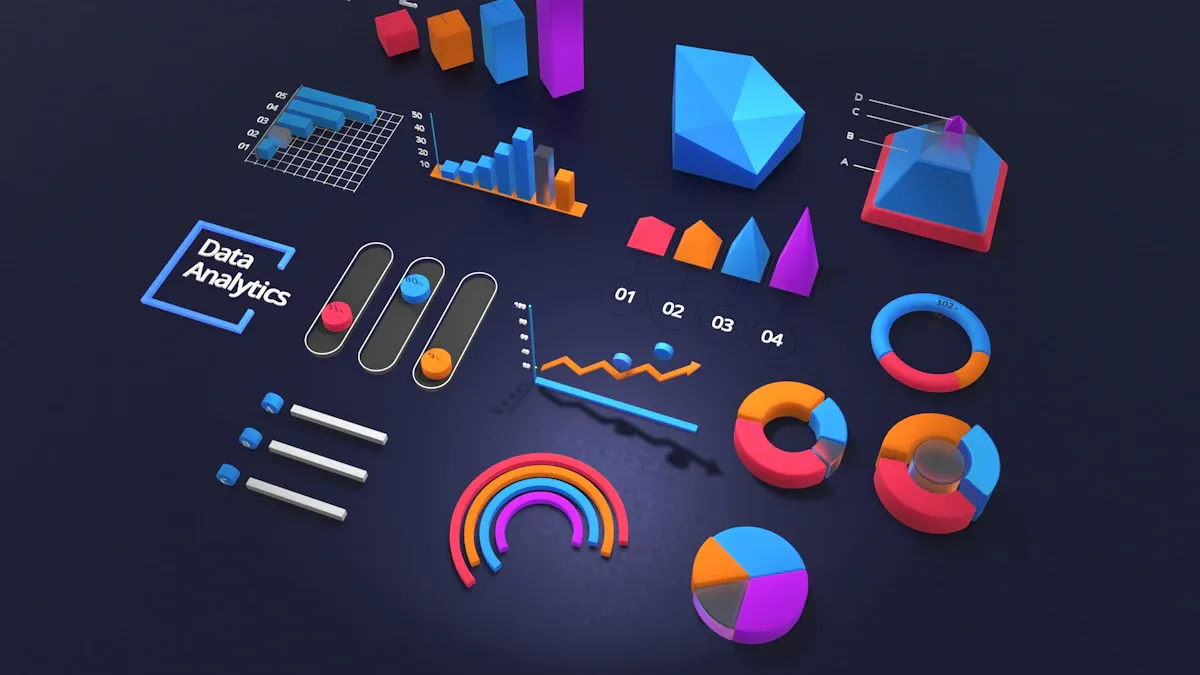
As 2025 approaches, data analytics is essential. You can use analytics to transform complex ESG regulatory requirements into clear sustainability strategies. Your sustainability data analytics bridges the gap between massive ESG data and real results. It provides the insights for compliance, risk management, and the transparency stakeholders want. The global ESG data market is growing fast, reflecting this urgent need for better analytics.
Companies using analytics for data-driven decisions will lead the way in ESG. Those that ignore their data face significant compliance risks in a changing regulatory landscape. Your analytics deliver the actionable insights for sustainability.
The Driving Need for ESG Data Analytics
The push for robust ESG practices comes from all sides. Investors, consumers, and regulators now demand transparency and accountability. This growing regulatory pressure forces you to move beyond simple statements and provide hard data. Your sustainability data analytics is the engine that powers this shift. It helps you understand external demands and turn them into a strategic advantage. Without strong analytics, you risk falling behind in a world that judges companies on their sustainability performance.
Meeting Mandatory Reporting Mandates
You face a rapidly growing web of ESG regulations. Governments worldwide are introducing over 40 new digital and ESG laws. These rules require detailed sustainability disclosures. The European Union’s Corporate Sustainability Reporting Directive (CSRD) is a prime example. It sets a new global standard for comprehensive ESG reporting. To achieve compliance, you must master your data.
Your sustainability data analytics helps you interpret these complex regulatory requirements. The CSRD, for instance, demands extensive data collection and reporting. Your analytics tools are essential for this task.
- Expanded Reporting: You must report on 12 standards and 82 requirements, covering environmental, social, and governance topics. Analytics helps you process this vast amount of information.
- Digital Tagging: The regulation requires you to submit machine-readable sustainability information. Data analytics makes this digital reporting possible.
- Third-Party Verification: Auditors will verify your ESG data. Strong analytics ensures your reporting is accurate and ready for inspection.
Non-compliance with regulations like the CSRD or the Sustainable Finance Disclosure Regulation (SFDR) carries significant risks. Penalties are designed to be a powerful deterrent.
-EU Directive 2013/34 on Annual Financial Statements
Fines vary by country but can be severe. In Germany, they can reach up to €10 million or 5% of your annual turnover. Effective data analytics is your first line of defense for ensuring compliance and avoiding these penalties. The Corporate Sustainability Due Diligence Directive (CSDDD) further increases the need for diligent data management across your value chain, making analytics indispensable for your due diligence.
Proactively Managing ESG Risks
ESG is not just about reporting; it is also about effective risk management. Your business faces physical risks from climate change and transition risks from shifting markets. Data analytics gives you the insights to identify, measure, and mitigate these threats. You can use analytics to translate climate projections into financial terms. This helps you understand how events like wildfires or floods could impact your assets.
Your analytics can model specific financial risks tied to ESG factors. This allows you to make better data-driven decisions and protect your bottom line. Consider these examples:
| Risk Category | Description | Analytics Application |
|---|---|---|
| Credit Risk | A borrower defaults on a loan due to climate-related events (e.g., crop failure from drought). | Model the probability of loan default under different climate scenarios. |
| Market Risk | Asset values decline due to changing consumer preferences for sustainable products. | Analyze market trends to predict shifts in demand away from high-emission goods. |
| Operational Risk | Supply chain disruptions from extreme weather events halt production. | Use predictive analytics to identify vulnerable points in your supply chain and develop contingency plans. |
Effective ESG due diligence processes depend on these insights. The Corporate Sustainability Due Diligence Directive makes this level of scrutiny a legal requirement. Your sustainability data analytics helps you perform the necessary due diligence to secure your operations. By analyzing historical and real-time data, you can forecast potential disruptions and build a more resilient business. This proactive approach to managing risks is key to long-term sustainability.
Gaining a Competitive Advantage
Strong ESG performance is no longer just a "nice-to-have." It is a core driver of competitive advantage. Investors increasingly use ESG metrics to evaluate a company's long-term value. In fact, 88% of institutional investors state that ESG factors are central to their investment decisions. They see a clear link between good ESG practices and strong financial returns. Your data analytics provides the actionable insights needed to improve your ESG metrics and attract investment.
A commitment to sustainability, backed by data, also strengthens your brand. It builds trust with customers and enhances your reputation. This leads to greater customer loyalty and stability. Good ESG performance improves your company's information environment, which fosters better communication and stronger partnerships.
Your analytics efforts directly translate into better business outcomes. Studies show a positive correlation between high ESG scores and financial performance. Companies with strong sustainability metrics often demonstrate:
- Better earnings fundamentals.
- Lower volatility and greater downside protection.
- A lower cost of capital.
By leveraging analytics for your ESG strategy, you do more than meet reporting requirements. You build a more resilient, reputable, and profitable business. This is the foundation of a successful sustainable transformation.
Benchmarking Performance Against Peers
To truly lead in ESG, you need to know where you stand. Benchmarking your performance against industry peers provides critical context for your sustainability efforts. ESG rating agencies like MSCI and ISS provide industry-specific benchmarks. They evaluate how well you manage ESG risks and opportunities compared to your competitors.
These ratings are highly influential. Investors use them to identify industry leaders and laggards. A high rating can improve your access to capital, while a low rating can flag you as a risky investment. Your sustainability data analytics is crucial for this process. It allows you to:
- Collect the Right Data: Gather the specific sustainability metrics that rating agencies use for your sector.
- Analyze Your Performance: Identify your strengths and weaknesses relative to peer benchmarks.
- Target Improvements: Use the insights from your analysis to focus your sustainability initiatives where they will have the most impact.
- Communicate Your Progress: Clearly report your performance improvements to investors and rating agencies.
By using analytics to benchmark your ESG performance, you can set meaningful goals and demonstrate your commitment to continuous improvement. This data-driven approach helps you turn your sustainability reporting from a simple compliance exercise into a powerful strategic tool.
Applying Sustainability Data Analytics in Practice

Understanding the need for ESG analytics is the first step. Now you must apply it. Your sustainability data analytics turns strategic goals into practical actions across your business. It provides the real-time insights you need for effective data-driven decisions. This moves your company from simply reporting on the past to actively shaping a better future. Your analytics efforts are the key to unlocking operational efficiencies and building a truly sustainable business model.
Building a Data-Driven Strategy
A strong ESG strategy needs a solid data foundation. You cannot manage what you do not measure. Your sustainability data analytics helps you build a clear, actionable plan. The first step is to conduct a materiality assessment. This process helps you identify the ESG issues that most impact your business and your stakeholders. It allows you to focus your resources on the topics that matter most.
A materiality assessment brings objectivity to your strategy. It helps you identify trends, highlight future risks, and uncover opportunities that create long-term value. This is a crucial part of your due diligence.
Once you identify your material issues, you can build your data-driven ESG strategy. This process ensures your efforts are focused and effective.
- Assess Your Current State: Use analytics to get a clear picture of your current ESG performance.
- Set SMART Goals: Define goals that are Specific, Measurable, Achievable, Relevant, and Time-bound. Your sustainability metrics will track your progress.
- Choose an ESG Framework: Select a framework like SASB or CDP to standardize your reporting and compare your performance against peers.
- Create Your Team: Assemble a dedicated team to manage your ESG data and drive your initiatives.
This structured approach uses analytics to transform your sustainability ambitions into a concrete plan for your sustainable transformation.
Improving Operational Sustainability
Your sustainability data analytics delivers powerful insights for improving your day-to-day operations. You can use analytics to find hidden inefficiencies and reduce your environmental footprint. This leads to both cost savings and better sustainability performance. Predictive analytics, for example, can optimize energy consumption and waste management in your facilities.
By analyzing historical energy use and production data, your analytics can:
- Pinpoint specific areas of energy waste.
- Forecast future energy needs to optimize allocation.
- Provide real-time recommendations for continuous improvement.
This data-driven approach enhances your sustainability by reducing your carbon footprint. It also improves operational efficiency and lowers costs by ensuring you only use the energy you need.
Logistics is another area where analytics makes a big impact. Optimizing transportation routes reduces fuel consumption and lowers emissions. Companies using analytics to refine their logistics have achieved transportation cost savings of 5% to 7%. These improvements demonstrate how your sustainability data analytics can directly benefit your bottom line while advancing your ESG goals. Your analytics provide the insights to manage operational risks effectively.
Automating Key Reporting Metrics
Manual ESG reporting is time-consuming and prone to errors. The growing complexity of compliance demands a more efficient solution. Automation is the answer. Your sustainability data analytics platforms can automate the collection, calculation, and reporting of key sustainability metrics. This ensures your data is accurate, consistent, and ready for audits.
You can streamline your reporting by following a few best practices for automation:
- Centralize Your Data: Use a single platform to consolidate all your ESG data for easier access and management.
- Automate Data Collection: Implement tools like smart meters and API integrations to reduce manual data entry.
- Standardize Calculations: Automate complex calculations for your metrics to ensure they align with frameworks like the GHG Protocol.
- Generate Reports Automatically: Use ESG software to create reports that meet specific compliance requirements for regulations like the CSRD.
Automating your carbon accounting is especially important. Specialized software platforms like Persefoni, Sphera, and Salesforce Net Zero Cloud can autonomously handle vast datasets for Scope 1, 2, and 3 emissions. These tools streamline supplier communication and make complex reporting manageable. Automation turns your reporting from a burdensome task into a strategic asset, freeing your team to focus on performance improvement.
Enhancing Supply Chain Transparency
Your supply chain holds significant ESG risks and opportunities. Gaining visibility into your suppliers' practices is essential for effective due diligence and comprehensive reporting. Your sustainability data analytics provides the tools to achieve this transparency. By analyzing supplier data, you can identify potential risks related to human rights, labor practices, and environmental impact.
New technologies are making this process even more powerful. For example, you can combine analytics with blockchain to create a secure, tamper-evident record of transactions. This technology improves traceability and builds trust among your supply chain partners, which is crucial for verifying ESG claims.
Data analytics also helps you proactively mitigate human rights risks. Many companies now use AI-driven analytics to monitor their supply chains for potential violations.
| Company/Sector | Analytics Application | Human Rights Risk Addressed |
|---|---|---|
| H&M | AI to scan supplier audit reports | Forced labor, unsafe conditions |
| Starbucks | AI with blockchain integration | Non-compliance with fair trade |
| Nestlé | NLP to review supplier contracts | Child labor, ethical standards |
| Apparel Brand | AI with salary data analysis | Unfair wages, poor worker conditions |
Using analytics for your due diligence helps you make better data-driven decisions. It allows you to identify and address risks before they become major problems. This deep level of insight is fundamental to building a resilient and ethical supply chain that supports your overall ESG mission.
Building Your ESG Analytics Toolkit

To master ESG, you need the right tools. Building your ESG analytics toolkit is a strategic process. It involves gathering the right data, using powerful platforms, ensuring data quality, and having the right people. Your sustainability data analytics depends on a strong foundation. This toolkit will power your reporting and decision-making.
Integrating Key Data Sources
Your sustainability data analytics starts with integrating diverse information. You need to combine data from both inside and outside your company. This gives you a complete view of your ESG performance.
- Internal Data: This includes operational records on energy use, HR data on workforce diversity, and details from your own sustainability reports.
- External Data: This comes from third-party providers like MSCI, regulatory filings, and industry benchmarks.
Your analytics must bring these sources together. This integration is the first step in creating meaningful sustainability metrics.
Leveraging ESG and BI Platforms
Specialized software makes your sustainability data analytics much easier. ESG platforms like Persefoni or Envoria help you automate data collection and reporting. These tools are designed for compliance with standards like the CSRD. You can also use Business Intelligence (BI) tools like Power BI. You can customize BI dashboards to track key ESG metrics in real-time. This helps you turn complex data into clear visuals for your team. Your analytics become more accessible and actionable.
Solving Data Quality Challenges
Poor data quality undermines your entire ESG effort. Manual data entry often leads to errors and inconsistencies. Your sustainability data analytics can help you solve these problems.
Inconsistent data makes it hard to track your performance over time. You risk being accused of greenwashing if your reporting is not based on accurate data.
You must implement data cleansing and validation techniques. Your analytics tools can identify and correct errors, fill in missing values, and standardize formats. This ensures your ESG metrics are reliable and ready for audits. Strong data governance is essential for trustworthy sustainability reporting.
Developing or Sourcing Expertise
Technology alone is not enough. You need people with the right skills to manage your sustainability data analytics. An effective ESG team includes roles like ESG Analysts and Sustainability Strategists. These experts collect and validate data, analyze trends, and prepare reports. They need strong analytical skills and proficiency with data analysis tools. They also need excellent communication skills to explain complex ESG topics to others. Your investment in analytics expertise is an investment in your company's sustainability.
Your data analytics is the essential engine for your ESG strategy. Your ESG analytics moves you beyond simple compliance. It is a strategic tool for building a resilient business and achieving sustainability. You must invest in your data analytics capabilities now.
💡 Your Next Step: An investment in your data and analytics is an investment in your future ESG success. This commitment to better ESG data ensures your long-term sustainability and competitive edge.
FAQ
What is ESG data analytics?
ESG data analytics is the process you use to measure your company's performance on environmental, social, and governance topics. You analyze data to find insights. These insights help you make better decisions, manage risks, and report your progress to stakeholders like investors and customers.
Why is ESG data so important for 2025?
New regulations like the CSRD become mandatory for many companies around 2025. You need accurate data to comply with these strict rules and avoid large fines. Good data also shows investors that your business is well-managed and prepared for the future.
How can my company start with ESG analytics?
You can begin by performing a materiality assessment. This helps you identify the most important ESG issues for your business. Then, you can start collecting relevant data from different departments. This creates a foundation for your entire ESG strategy and reporting process.
What are the best tools for ESG data analytics?
You have several great options for your analytics toolkit. 🛠️
| Tool Type | Examples | Best For |
|---|---|---|
| ESG Platforms | Persefoni, Sphera | Automating compliance reporting |
| BI Tools | Power BI, Tableau | Creating custom visual dashboards |
These tools help you organize data, track your key metrics, and generate reports efficiently.
See Also
Optimizing Retail Inventory: Predictive Analytics for Future Re-stocking Strategies
Leveraging AI and Data for Accurate Demand Forecasting in the Coming Year
Enhancing Product Assortment Decisions Through Powerful Data Analytics Insights
Achieving Equilibrium: Predictive Analytics Harmonizes Fashion Supply and Consumer Demand
Transformative Impact of AI Sensors on the 2025 Fashion Supply Chain